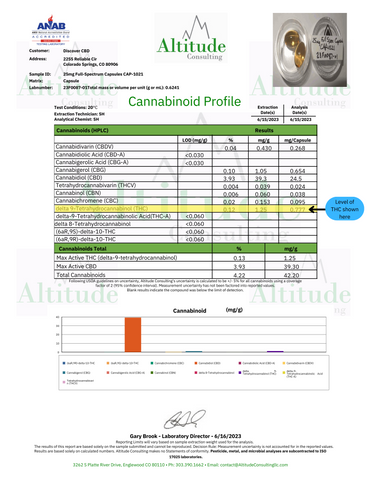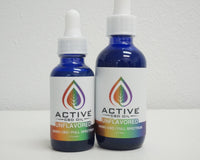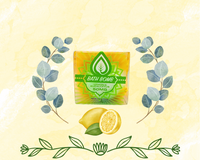Do you have drug screen concerns and need to avoid having any THC in your system, but want to try out CBD? Well the good news is that not all CBD products will contain THC however it is important to see for yourself that the products are truly THC free rather than just taking a company’s word for it. The best way to determine whether your CBD product will in fact be THC free is by looking at the third party lab results for the batch of your product in question. Here at Discover CBD we completely understand your concerns and want to help you understand where to find our lab results and what to look for once you get there as we break down the different parts of a lab result.
Where to find your lab results?
Any responsible consumer will want to know exactly what they are putting into their body and it should never be difficult to find this information out. We have always valued having transparency with our customers for what is in our products and wanted to make it accessible for everyone to know exactly how much CBD is in their product and if there is any amount of THC.
We were one of the first CBD companies to include a QR code on every product we make that you can easily scan with your smartphone camera to take you directly to our Active CBD Oil lab results page. Every product will have a corresponding batch number (ex: CAP-1019) on the label that you can directly search for. Alternatively you can filter by category of products such as capsules to look ahead of time what batch you would get if you place an order online. If you ever have any questions as to what batch your order will be before we ship please feel free to give us a call at 719-666-7219 and we will be happy to let you know!
What is a Cannabinoid Profile?
CBD is one of over a hundred plus different cannabinoids in the hemp plant that all have their own potential benefits. If you are using a product that is made using more of the hemp extract then there will likely be other cannabinoids such as CBG, CBN and CBC that will show up in the lab results. The main goal of the 3rd party lab testing is to determine the breakdown of how much of each cannabinoid exists in any given product. Since every hemp plant is unique, test results will vary from batch to batch in terms of the potency of each cannabinoid.

Different parts of a lab result
To start things off let’s breakdown the different important parts of a lab result so that you know exactly what to look for. We will use our Active CBD Oil Water Soluble Broad Spectrum Capsules as an example a lab report without THC detected:

In contrast let’s take a look at what a lab report that does show the trace amounts of THC looks like with our Active CBD Oil Full Spectrum capsules:

Types of CBD products
CBD products fall into one of three categories based on how they are made; whether that be full spectrum, broad spectrum or an isolate product. In the search to discover what product may be right for each individual, it may be helpful to understand the main differences in these types of products to consider.
Full Spectrum
The full hemp extract with everything the hemp plant has to offer, including over a hundred different cannabinoids, terpenes, flavonoids, and amino acids that could each have their own potential benefits. Studies suggest that products made using more of these hemp components could encourage the entourage effect, where all these components may have more synergistic effects and work better together as a team effort. An important distinction to make with full spectrum products derived from hemp is that they will contain trace amounts of THC of 0.3% or less. This is not enough to produce any psychoactive effects, but could still provide additional potential benefits. However any amount of THC may show up on a drug screen, so for anyone that does have drug screen concerns, we typically see them avoiding the full spectrum options. Since full spectrum oils are the least processed form of CBD, they tend to have a much darker green color to them due to chlorophyll from the hemp plant. Research indicates that full spectrum products tend to have the widest range of potentially effective doses as they show a more linear dosing pattern where an individual may continue to increase their dose and still see more potential benefits.

Broad Spectrum
The full hemp extract will be filtered to remove the THC while preserving other cannabinoids, terpenes, and flavonoids through a process called chromatography. This makes broad spectrum a popular choice for people looking for a product that can encourage the entourage effect while still being THC free. Both broad spectrum and full spectrum products will typically have a natural earthy plant taste of hemp due to the terpenes, which give plants their natural flavor and smell as well as having their own potential benefits. Broad spectrum oils usually look less dark than full spectrum and have a more golden color since many other plant constituents are removed during refinement. Research suggests that broad spectrum products tend to have a moderate range of potentially effective doses that may span slightly less than full spectrum, yet have a larger range than isolate products.
Isolate
CBD completely removed from the rest of the hemp plant in its purest form will typically start out as a crystalline powder and can be as high as 99% in purity. Unlike broad or full spectrum, isolate products will not have an entourage effect or taste like hemp. Isolate products tend to be much cheaper, especially for those that like to make their own products using CBD isolate powder to make tinctures, edibles, topicals, and vaping products.. Isolate tinctures may vary in color depending on what oil base the isolate is infused into, and can range from clear to a light purple or red if there is more light exposure. Research suggests that CBD isolate products have the most narrow range of potentially effective doses and tend to work on a bell curve, where taking too high of a dose, past our optimal dose, may have diminishing results. This is why we typically see most people new to trying any CBD product start with lower doses and gradually increase as needed.


























